Blending coastal decor with other design styles is like creating a harmonious symphony—each element contributes its unique charm while working together to achieve balance. Whether you love the relaxed vibe of coastal design but crave the elegance of traditional decor or want to combine beachy hues with modern minimalism, mixing styles allows you to create a personalized, layered space that tells your story.
When I first started experimenting with combining coastal decor and other styles, I was hesitant. Would a sleek mid-century modern chair clash with a jute rug? Could I pair a rustic farmhouse table with oceanic blues? But as I played with textures, colors, and shapes, I discovered that blending styles is all about balance and intention. My once-disjointed space became a cohesive, inviting retreat that perfectly reflected my taste.
Here’s how you can seamlessly blend coastal decor with other design styles to create a space that feels unique and curated.
1. Coastal + Modern: Sleek and Breezy
Why It Works
Coastal design’s light and airy feel pairs beautifully with the clean lines and minimalism of modern style.
How to Do It
- Use a neutral base of white or light gray, then add pops of blue for a coastal touch.
- Pair sleek modern furniture with natural coastal materials like rattan or jute.
- Choose simple, understated decor like abstract ocean-inspired artwork or clear glass vases.
Styling Tip:
A white mid-century modern sofa with a jute rug and a rattan pendant light creates a perfect balance of modern and coastal elements.
2. Coastal + Bohemian: Relaxed and Eclectic
Why It Works
Both styles celebrate a relaxed, free-spirited vibe, making them a natural pairing.
How to Do It
- Layer textures like macramé, woven throws, and jute rugs.
- Mix coastal blues and whites with warm, earthy tones like terracotta and mustard.
- Incorporate eclectic decor like patterned pillows, hanging plants, and vintage coastal art.
Example:
A wicker chair with a macramé throw pillow, a colorful kilim rug, and a seashell-framed mirror strikes a balance between boho and coastal.
3. Coastal + Farmhouse: Rustic and Refined
Why It Works
Farmhouse style’s emphasis on natural materials and cozy textures complements the breezy, lighthearted nature of coastal design.
How to Do It
- Use distressed wood furniture paired with coastal-inspired textiles like striped throws or linen curtains.
- Add coastal decor like driftwood, sea glass, or nautical accents sparingly.
- Stick to a neutral palette with pops of navy or soft blue.
Styling Tip:
Pair a whitewashed farmhouse table with wicker chairs and a ceramic vase filled with pampas grass for a rustic coastal dining space.
Picture Gallery
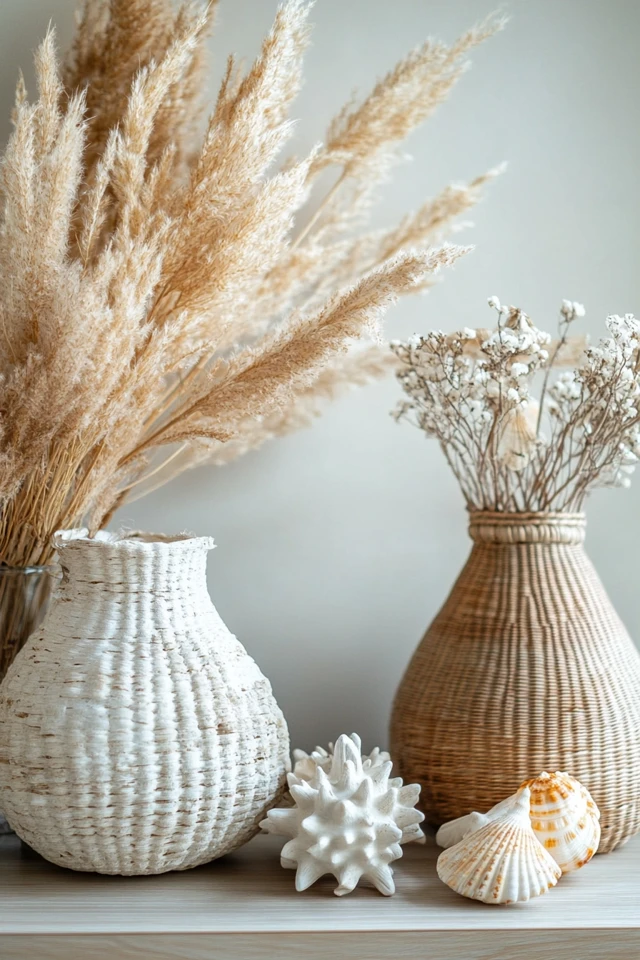

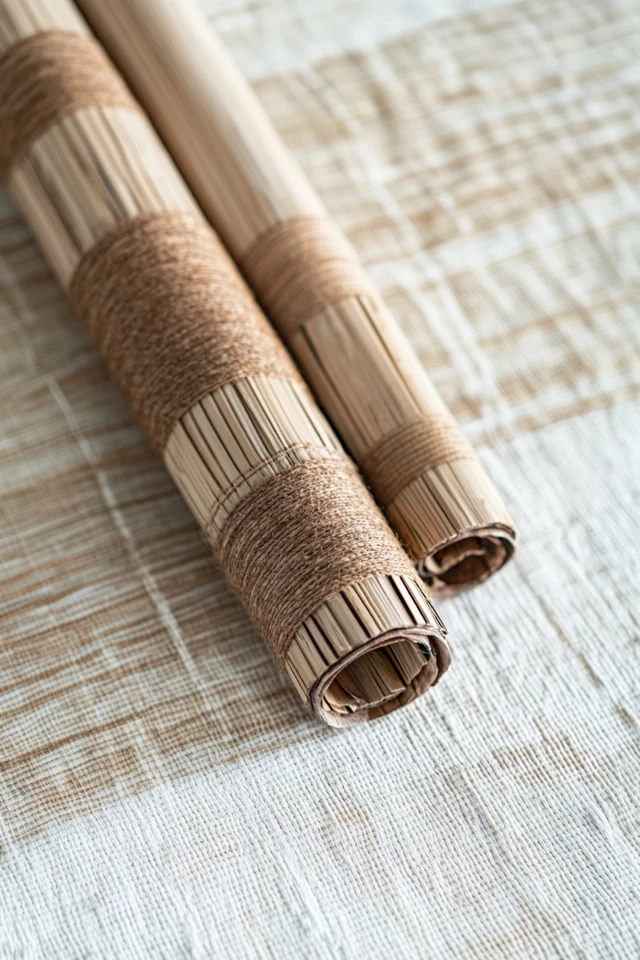
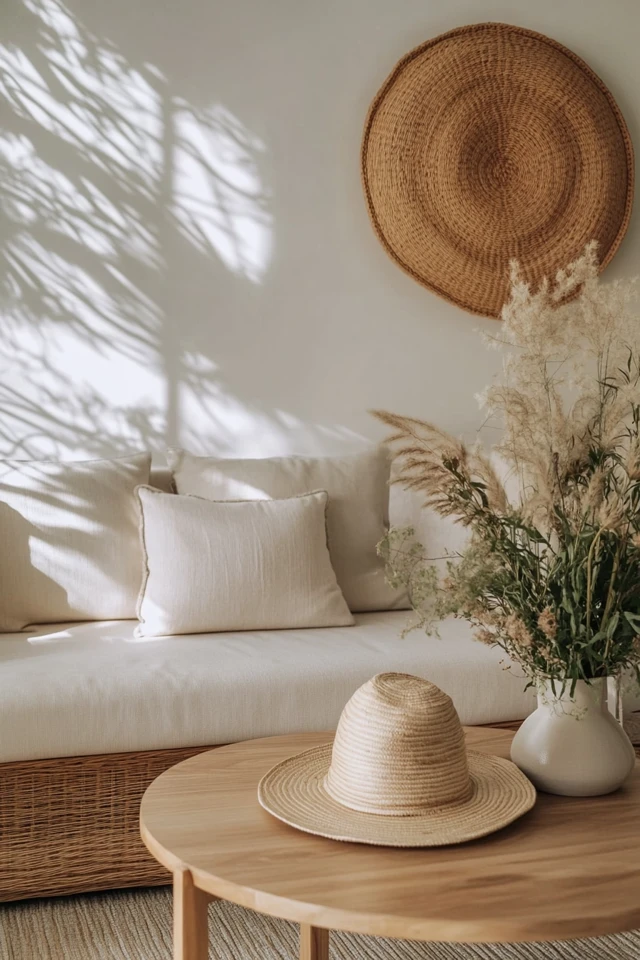
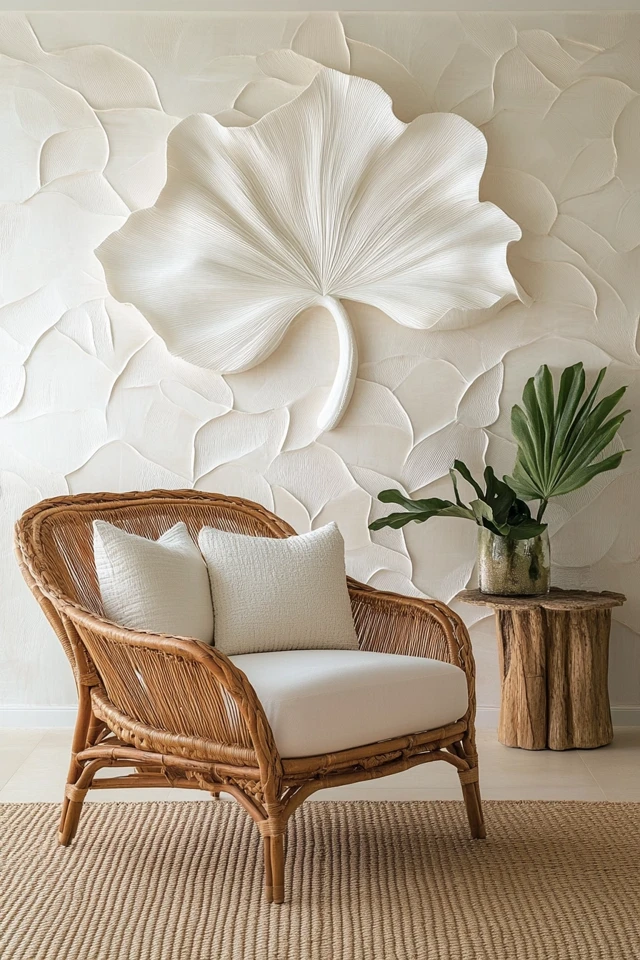

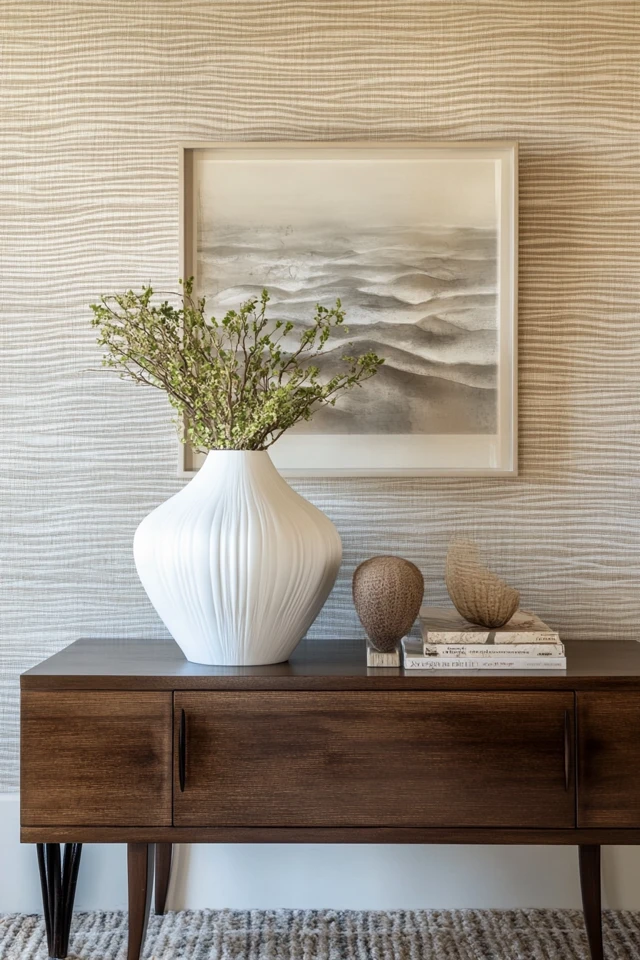
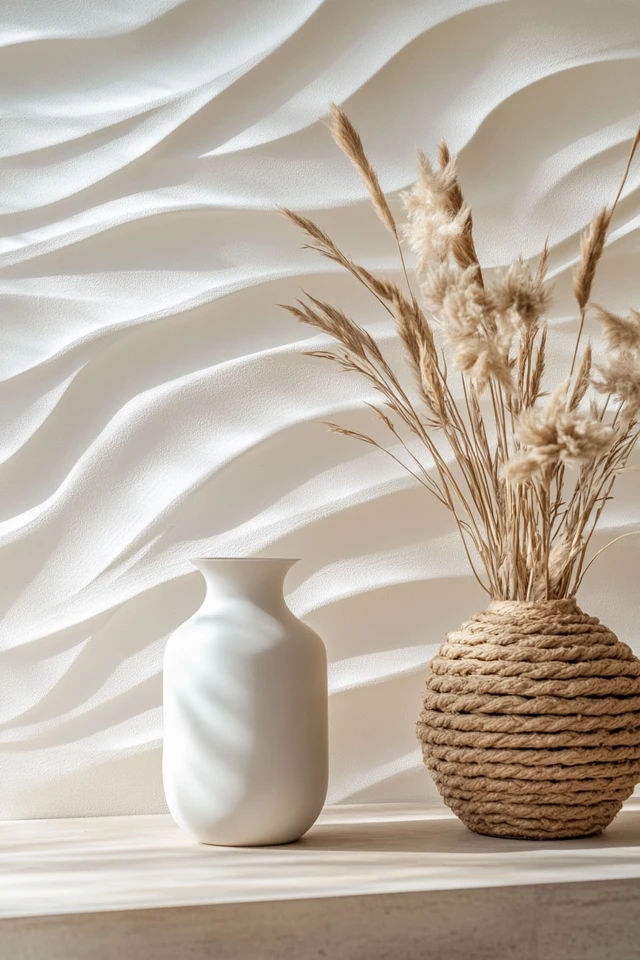

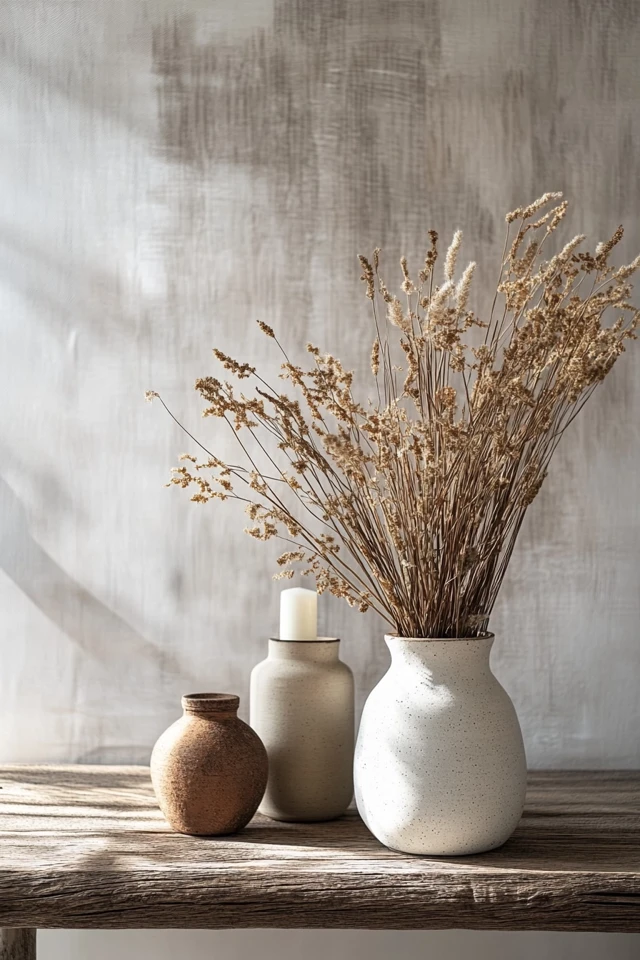
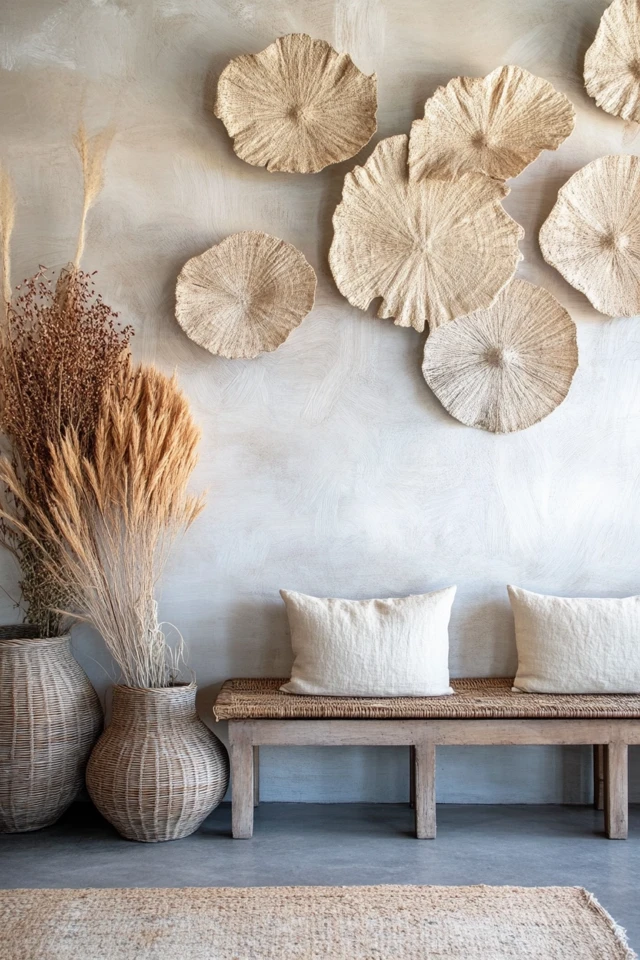
4. Coastal + Traditional: Timeless and Sophisticated
Why It Works
Traditional design’s classic details and rich textures add depth and refinement to casual coastal spaces.
How to Do It
- Combine traditional furniture, like tufted sofas or wingback chairs, with coastal colors and decor.
- Use patterned textiles, such as a blue-and-white damask rug or striped pillows.
- Add brass or gold accents, like picture frames or table lamps, to elevate the coastal vibe.
Example:
A navy tufted armchair with a rope-wrapped side table and a brass lamp blends traditional and coastal elements seamlessly.
5. Coastal + Minimalist: Simple and Serene
Why It Works
Coastal design’s light, airy aesthetic aligns perfectly with minimalism’s “less is more” philosophy.
How to Do It
- Stick to a monochromatic palette of whites, beiges, and soft blues.
- Choose furniture with clean lines and avoid heavy or bulky pieces.
- Limit decor to a few well-chosen items, like a driftwood sculpture or a single piece of ocean-inspired art.
Styling Tip:
A white sofa with a single blue throw pillow and a clear glass coffee table creates a minimalist coastal vibe.
6. Coastal + Industrial: Raw and Breezy
Why It Works
Industrial design’s edgy, urban feel contrasts beautifully with coastal decor’s softness and lightness.
How to Do It
- Combine industrial materials like metal and concrete with coastal elements like wood and rattan.
- Use a neutral base, such as gray or black, and soften it with coastal-inspired textiles.
- Add decor like industrial pendant lights paired with woven baskets or sea glass accents.
Example:
A concrete coffee table with a wicker chair and a soft blue throw blanket brings the industrial and coastal worlds together.
7. Coastal + Scandinavian: Cozy and Fresh
Why It Works
Both styles emphasize light colors, natural materials, and functional, uncluttered design.
How to Do It
- Use a predominantly white palette with touches of blue and natural wood.
- Choose sleek, functional furniture and add coastal touches through textiles and decor.
- Layer cozy throws and pillows for a touch of Scandinavian hygge.
Styling Tip:
A light wood dining table with woven chairs and a striped runner creates a Scandinavian-coastal dining space.
8. Coastal + Glam: Luxe and Light
Why It Works
The breezy, casual vibe of coastal design is elevated by glam’s metallic finishes and luxurious textures.
How to Do It
- Combine soft blues and whites with metallics like gold, silver, or brass.
- Use luxurious fabrics like velvet or silk in coastal-inspired hues.
- Add statement lighting, like a crystal chandelier or a gold pendant light, to glam up the space.
Example:
A navy velvet sofa with gold-framed mirrors and a jute rug combines coastal charm with glamorous elegance.
9. Coastal + Mid-Century Modern: Retro and Relaxed
Why It Works
Mid-century modern’s clean lines and vintage flair pair effortlessly with the laid-back feel of coastal design.
How to Do It
- Use mid-century furniture in light wood tones or white finishes.
- Add pops of coastal color with pillows, rugs, or wall art.
- Incorporate decor like ceramic vases, abstract art, or driftwood sculptures.
Styling Tip:
A light wood credenza with brass hardware, styled with a ceramic vase and a piece of coral, blends mid-century and coastal aesthetics.
How to Successfully Blend Styles
- Stick to a Cohesive Color Palette: Use colors that overlap between the styles, like soft neutrals or ocean-inspired hues.
- Balance Materials: Mix natural coastal textures like rattan or jute with the signature materials of your other style, such as metal for industrial or velvet for glam.
- Choose Key Pieces: Select a few statement pieces from each style to anchor the design, and let the rest of the decor support those choices.
- Avoid Overcrowding: Be intentional with decor and furniture placement to maintain an uncluttered, harmonious look.
- Use Transitional Decor: Look for items that blend elements of both styles, such as a rattan chair with metal legs or a tufted bench with a distressed wood finish.
Conclusion
Blending coastal decor with other design styles allows you to create a space that’s uniquely yours—relaxed yet sophisticated, airy yet grounded. Whether you prefer the simplicity of minimalism, the charm of farmhouse, or the glam of metallics, coastal design can adapt to any aesthetic.
When I started mixing coastal decor with my love for modern furniture, it was like magic. The light, natural elements of coastal design brought warmth and personality to my sleek, contemporary space, making it feel less like a showroom and more like home.
Now it’s your turn! Use these tips to experiment with different styles and create a blended design that feels effortlessly chic and completely personalized.
FAQ
Can coastal decor work with bold, colorful styles?
Yes! Pairing coastal neutrals with bold colors like teal, coral, or mustard can create a lively, eclectic look.
What’s the easiest way to blend coastal and farmhouse styles?
Focus on natural materials like wood and wicker, and combine coastal colors with farmhouse-style furniture.
How do I avoid clashing when mixing design styles?
Stick to a cohesive color palette and balance bold pieces with subtle, complementary elements.
Can coastal design be incorporated into small spaces?
Absolutely! Coastal design’s light colors and airy feel can make small spaces appear larger and more open.
What’s the most versatile style to pair with coastal decor?
Modern and minimalist styles blend seamlessly with coastal decor due to their shared emphasis on simplicity and lightness.


